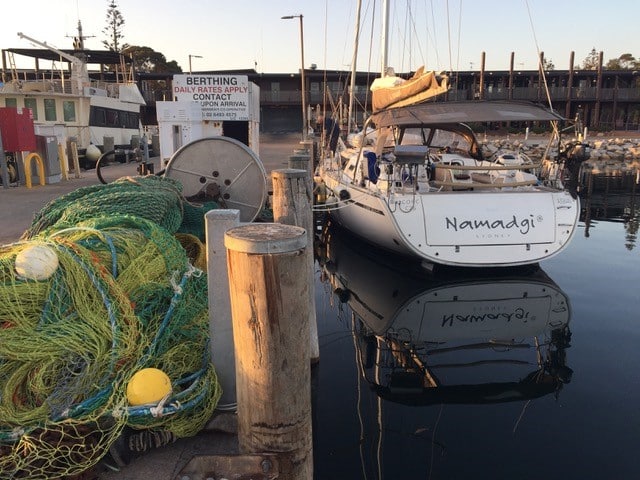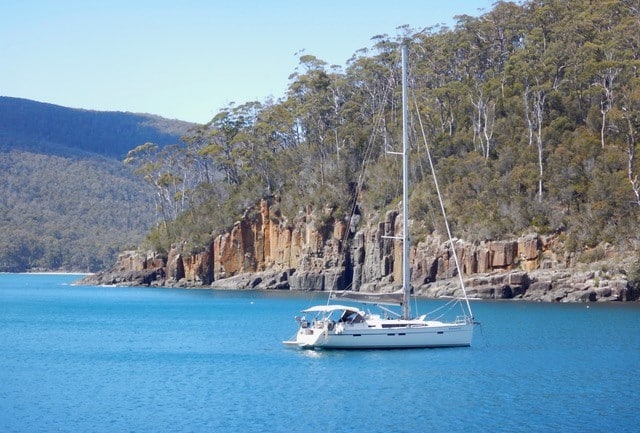Yachts and ocean racing aren’t what comes to mind when you think of Canberra waterways, however, the Canberra Ocean Racing Club (CORC) sees beyond our rivers and manmade lakes. Members of the club set sail on near and distant waters onboard their luxury yacht, Namadgi 3.
Formed in 1979, CORC was born when a group of like-minded coastal and offshore sailing enthusiasts formed a plan that would enable them to compete in ocean racing events and be part-owners of the vessel.
“It is a great way to get into sailing, a great way to get into being able to access a boat that you may not otherwise be able to afford. You get to build your skills and experience along the way,” says Michelle Grybaitis.
Ms Grybaitis wears many hats in the club: she is the current president, editor of their newsletter Spindrift, and the safety officer. Ownership of the yacht, which is berthed in Sydney when not being sailed, is shared by 26 debenture members.
The club has two levels of membership: debenture and associate. A debenture member holds part ownership of the yacht and helps maintain the operating costs at a level reflective of their sailing time. An associate member may one day be offered the opportunity to buy a debenture membership; they are invited to the club’s social functions, sail days, and often on trips with members. There are currently around 40 associates.
Growing up on a farm in central NSW, Ms Grybaitis wasn’t exposed to sailing in her youth. She had gone sailing when on holiday around places like Turkey and began dreaming of sailing around the Mediterranean. Then Ms Grybaitis and a friend started attending the Sydney International Boat Show with big plans.
“Initially I was looking at a motorboat, I got my boat licence. My friend who I went with was into motorboats as well, and then contemplated sailing. I was thinking if we are going to do this, one of us needs to have some sailing skills,” she smiles.
It was around 2012 when she took the sailing courses. While out at dinner, Ms Grybaitis met a former CORC president who suggested the club could be a good option for her. Nervous but curious, she attended the next social event where she felt welcomed and was encouraged to apply for associate membership.
She was an associate for more than seven years before becoming a debenture member. During this time, she was active, attending social events and sail days when she could. She took over the role of editor of the newsletter, something that hadn’t been given to an associate member before. Ms Grybaitis also bought her own 26-foot yacht before being offered part ownership of Namadgi 3 as a debenture member.
When a part-owner wants to sell their share, there are procedures in place. The next part-owner is an associate member chosen by the committee, selecting who they think is the best match for the club, based on how long they’ve been in the club, participation in events and working bees, and sailing experience.
“That gives us a gauge of their commitment to the club and also what sailing experience they’ve got. We like people to have a boat licence at least, so they know the basics of the rules,” she says.
The price is a percentage of the current value of the boat, which depreciates over time. The club’s treasurer takes on the role of valuing the membership, including the vessel and various assets, before dividing by 26.


Namadgi 3 is 46-foot long with four cabins that can each sleep two people; it also has showers and three heads – the nautical term for toilet. Boats are replaced as they age; Ms Grybaitis says the current yacht is the sixth or seventh the club has owned over the decades.
More processes are in place when it comes to selecting a new vessel, with a committee or subcommittee researching options and surveying members to find out what sort of boat they would like. Club members vote, then negotiations begin for purchasing.
CORC has a depreciation fund to help put down a deposit on the new yacht while they set about selling the older one to help cover costs – though “members might have to put in a couple of thousand extra each to fill the gap,” Ms Grybaitis says.
The demographic of the group is a mix of people who have been sailing most of their lives and those who have started in recent years. Ms Grybaitis says debenture members vary in age from their 50s to their 70s, while some associate members are as young as 18.
“They range right through the age ranges. Again, that associate membership gives people the opportunity to get to know us, get to know the boat, get to spend time sailing,” she says.
Namadgi 3 spends about 80 per cent of the year sailing waters near and far, and members’ time aboard varies based on their availability, with members often sailing together.
The booking officer puts together the calendar for the sailing program which people can apply for when they want to spend time on the yacht. Knowing roughly where the boat will be allows people to plan if they need to fly into a nearby city. Associates and relatives can be invited to join members as well. For the passages, where they travel between countries (e.g., New Zealand to Fiji) or destinations (e.g., Sydney to the Whitsundays), the club ensures there are experienced members on board.
“Then when we’re cruising, we say ‘okay, the boat’s going to be here for three months, these are the available dates’. People put in an expression of interest and the booking officer works that all around and allots everyone their space,” she ays.
When it comes to race time, some of the serious racing members might spend every weekend on the boat in preparation.
The club has previously competed in 15 Sydney to Hobart races, but with changing safety standards, Namadgi 3 no longer meets the requirements. That doesn’t stop the team from entering different races though, such as at Port Stephens, Hamilton Island, and Airlie Beach Race Week.
“The people who tend to want to race and get selected, we need at least half who have extensive experience,” she says.
This year is a big one for the club, with Namadgi 3 to be away from Australia for several months sailing places like New Zealand and Fiji. The club has held a number of working bees to check everything is fully operational before setting off.
Ms Grybaitis says working bees and social events are important avenues for associates to connect with members who may have upcoming trips. She sailed thousands and thousands of miles when she was an associate through the connections she made.
“That was fundamentally I think because I was regularly involved in the club’s activities, and I made myself known to the skippers. I’d ask them ‘do you need crew for that passage’,” she says.
Whether sailing with fellow members, racing yachts at Hamilton Island, or cruising with family and friends, CORC provides its members an opportunity to explore the sea from a larger vessel that might otherwise be out of reach.
“I’ve got friends within the club that I call on and I’ve got friends outside the club; I try to have a bit of a mix because that’s what you want,” smiles Ms Grybaitis.
Find out more about Namadgi 3 and the Canberra Ocean Racing Club at corc.com.au
Get all the latest Canberra news, sport, entertainment, lifestyle, competitions and more delivered straight to your inbox with the Canberra Daily Daily Newsletter. Sign up here.



